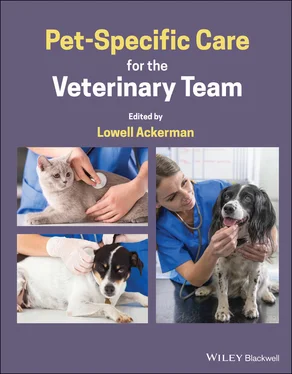For most pets, family history or breed predisposition is a significant contributor to disease susceptibility. This is true whether the pet is purebred or mixed‐breed. In many instances, when a pet is mixed‐breed and the parents have not been identified with certainty, it may be difficult to discern any type of predisposition without performing breed composition genetic testing. Whether purebred or mixed‐breed, both genotypic and phenotypic testing can be done for disease susceptibility.
Exposure risks constitute another significant contributor to disease susceptibility. For example, a pet exposed to many other pets will be at increased risk for infectious diseases and, potentially, parasite transmission. A dog that is taken for walks in wooded areas may be exposed to ticks that are enzootic to the region and may introduce tick‐related infections to the pet. A cat that is allowed to wander the neighborhood may be exposed to a variety of infectious diseases, as well as injury from vehicles, other pets, and wildlife.
Susceptibility to medical problems is also influenced by life stages. For example, an umbilical hernia is more likely to be congenital and evident in a juvenile pet, while most cases of hypothyroidism present during adulthood (see 4.1Canine and Feline Life Stages).
A pet's gender as well as its neuter status also influence risk. Some diseases are sex limited in nature (such as prostatic disease in males or pyometra in females), but there are also sex predispositions for a variety of disorders. For example, there may be a modest sex predisposition to females regarding cutaneous lupus erythematosus, while adrenal sex hormone imbalance (alopecia X) may be more commonly diagnosed in males. This is different from disorders transmitted genetically on the sex chromosomes. For example, hemophilia is more often clinically evident in males because the condition is transmitted on the X chromosome as a sex‐linked recessive condition, and since males only have one X chromosome (the other is a Y chromosome), they manifest the condition; in females, with two X chromosomes, it would take two copies of the hemophilia mutation before the condition would be apparent. Neuter status also affects risk. Bitches spayed before their first estrus have a reduced prevalence of mammary cancers; neutered males have a lowered risk for prostatic hyperplasia (see 4.2Gender‐Related Considerations).
Geography also plays a significant role in disease susceptibility, partially because it influences infectious diseases that are present in the area, or the vectors that are associated with their transmission. Accordingly, when creating personalized care plans, it is important to take into consideration whether or not the pet may travel outside the region.
Even conformation and nondisease traits can be associated with predisposition to disease. For example, cats with white fur may be at higher risk for developing squamous cell carcinoma; color dilution alopecia is more common in dogs with diluted coloring patterns, such as “blue” Dobermans.
3.4.4 Genotypic and Phenotypic Testing
Since pet‐specific care is about anticipating problems before they happen, typically through surveillance, screening tests are paramount to the process. The main categories of screening tests are based on phenotypic and genotypic assessment (see 3.11Integrating Genotypic and Phenotypic Testing).
Genotypic tests assess a genetic mutation or marker to determine disease susceptibility. Such genetic tests measure either the presence of an actual genetic variant or genetic markers that appear to be associated with phenes. Genetic tests typically measure a specific variant associated with disease, while genomic tests may be used for more complex diseases in which there may be interactions among genes, and between genes and the environment; information may be assessed for disease susceptibility, prognosis, or likely response to therapy.
When it comes to genetic testing, there are many DNA tests that can be run, either individually or as part of a panel ( http://bit.ly/2YWXBsc). For those that are only concerned with a single medical issue, individual genetic tests can be conducted. From a medical perspective, the most valuable information typically comes in the form of genetic panels in which multiple genetic tests are run at the same time (see 3.11Integrating Genotypic and Phenotypic Testing). This will evaluate for dozens of medical conditions, as well as for certain traits (e.g., conformation, color, etc.). Sometimes specific breed profiles are requested, evaluating only conditions common in a specific breed, although with the new “chip” technologies, it is as inexpensive to run a complete panel with dozens or hundreds of tests as it is to run a handful of tests common in a specific breed. In almost all cases, it makes more sense (financial and otherwise) to run the complete profile rather than try to guess which tests might be most relevant. However, after running such a panel, it is necessary for the hospital team to determine which tests are actually relevant for each individual pet (see 3.8Genetic Counseling).
Phenotypic tests are those that measure a detectable abnormality or variance from normal, rather than a genetic variant. This includes most of the tests we routinely use, such as hemograms, biochemical profiles, urinalysis, radiography, etc. For example, while genotypic tests can identify some variants of primary open‐angle glaucoma susceptibility at birth, phenotypic tests that rely on measurements of intraocular pressure (IOP) identify glaucoma when IOP increases above an established reference interval (range) for the breed.
Nutrigenomics will likely also play more of a role in healthcare with improved technology. There are several direct‐to‐consumer testing possibilities that purport to tell consumers how their eating habits could be associated with genetic predisposition and how sensitive they are to certain foods. Because of complicated environment–gene interactions, how individuals metabolize foods, and the role of the gut microbiome (see 4.6Role of the Microbiome), this would be potentially complicated to interpret in pets.
Collecting relevant information from pet owners is critical to being able to provide truly personalized care for pets. Since pets spend much more time with their owners than with veterinary staff, pet owners must be engaged in the process and aware that such information sharing will ultimately benefit their pets.
Every hospital visit provides an opportunity to learn more about the pet, the pet owner, and how they interact with one another. In many cases, it is most efficient to use questionnaires to standardize the collection process (see 1.2Providing a Lifetime of Care).
Important topics include understanding what other pets may co‐exist in the house, activities, and exposure, diets being fed, prescription and nonprescription medications being administered, etc.
It is also important to realize that preexisting conditions may be associated with increased risk for other disorders. For example, a pet diagnosed with Cushing's syndrome likely has an increased risk for diabetes mellitus. A pet with excessive skinfolds is likely predisposed to skinfold dermatitis. A pet with early radiographic evidence of hip dysplasia is more likely to develop osteoarthritis.
The benefit for veterinary practices is that pet‐specific counseling is an important part of a personalized approach to healthcare, and research shows that hospitals that practice such client‐centric care typically have significant growth year on year, compared to practices that do not provide this type of service (see 10.11The Financial Benefits of Pet‐Specific Medicine).
Читать дальше












